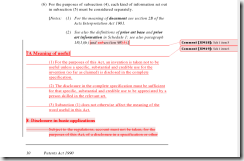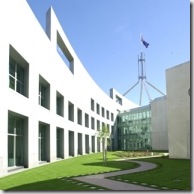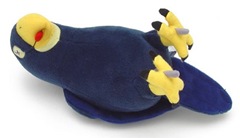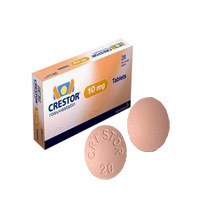Jonker v Platform Solutions Pty Ltd [2012] FCA 237 (15 March 2012)
Interlocutory injunction – strength of prima facie case of infringement – strength of prima facie case of invalidity – irreparable injury – balance of convenience
 A Federal Court judge has granted a preliminary injunction against a Brisbane-based supplier of industrial work platforms and telehandlers after one of the company’s directors told a patent-holder to ‘just do what you want’ because ‘patents aren’t worth the paper they’re written on.’
A Federal Court judge has granted a preliminary injunction against a Brisbane-based supplier of industrial work platforms and telehandlers after one of the company’s directors told a patent-holder to ‘just do what you want’ because ‘patents aren’t worth the paper they’re written on.’
In retrospect – and particularly in the year that Apple managed to keep Samsung’s Galaxy Tab 10.1 out of the Australian market for four months based on its patent rights – this seems like a brave challenge. In the event, it has cost Mitchell Ely and his company Platform Solutions Pty Ltd a trip to the Federal Court, where they have been unsuccessful in defending against an application for an urgent interlocutory injunction brought by John Jonker and his company Jonker Plant Hire Pty Ltd. The injunction will prevent Platform Solutions from commercially exploiting a mobile lighting apparatus said to infringe an innovation patent owned by Mr Jonker.
To a considerable extent, Ely was his own worst enemy in this case. His response to initial contact from Jonker became the primary basis for the court’s finding that there was a sufficient probability of patent infringement to support an injunction. There is a lesson in this about the dangers of making any form of reply to a threat of patent infringement proceedings without the benefit of legal advice.
Interlocutory injunction – strength of prima facie case of infringement – strength of prima facie case of invalidity – irreparable injury – balance of convenience
 A Federal Court judge has granted a preliminary injunction against a Brisbane-based supplier of industrial work platforms and telehandlers after one of the company’s directors told a patent-holder to ‘just do what you want’ because ‘patents aren’t worth the paper they’re written on.’
A Federal Court judge has granted a preliminary injunction against a Brisbane-based supplier of industrial work platforms and telehandlers after one of the company’s directors told a patent-holder to ‘just do what you want’ because ‘patents aren’t worth the paper they’re written on.’In retrospect – and particularly in the year that Apple managed to keep Samsung’s Galaxy Tab 10.1 out of the Australian market for four months based on its patent rights – this seems like a brave challenge. In the event, it has cost Mitchell Ely and his company Platform Solutions Pty Ltd a trip to the Federal Court, where they have been unsuccessful in defending against an application for an urgent interlocutory injunction brought by John Jonker and his company Jonker Plant Hire Pty Ltd. The injunction will prevent Platform Solutions from commercially exploiting a mobile lighting apparatus said to infringe an innovation patent owned by Mr Jonker.
To a considerable extent, Ely was his own worst enemy in this case. His response to initial contact from Jonker became the primary basis for the court’s finding that there was a sufficient probability of patent infringement to support an injunction. There is a lesson in this about the dangers of making any form of reply to a threat of patent infringement proceedings without the benefit of legal advice.

 Patentology is indebted to fellow attorney
Patentology is indebted to fellow attorney  Hot on the heels of a
Hot on the heels of a  Last week, Yahoo! sued Facebook in a US Federal District Court in San Jose, alleging that the soon-to-be public social media giant is infringing ten Yahoo! patents relating to online advertising, privacy, Web customization, social networking, and messaging. (See
Last week, Yahoo! sued Facebook in a US Federal District Court in San Jose, alleging that the soon-to-be public social media giant is infringing ten Yahoo! patents relating to online advertising, privacy, Web customization, social networking, and messaging. (See  For many years it has been the practice of the Australian Patent Office to accelerate examination of a patent application upon request by the applicant. The authority to expedite examination is bestowed by
For many years it has been the practice of the Australian Patent Office to accelerate examination of a patent application upon request by the applicant. The authority to expedite examination is bestowed by  What do you do if you have an issue with a Registered Australian Patent or Trade Marks Attorney?
What do you do if you have an issue with a Registered Australian Patent or Trade Marks Attorney? At least five Australian pharmaceutical manufacturers are now ready to launch generic versions of cholesterol-lowering drug CRESTOR, while being barred from doing so pending the outcome of litigation over three patents held by the original manufacturer, AstraZeneca AB.
At least five Australian pharmaceutical manufacturers are now ready to launch generic versions of cholesterol-lowering drug CRESTOR, while being barred from doing so pending the outcome of litigation over three patents held by the original manufacturer, AstraZeneca AB.
 In the first Federal Court decision to follow the ruling of the Full Court in Samsung v Apple (see
In the first Federal Court decision to follow the ruling of the Full Court in Samsung v Apple (see  We recently reported passage of the
We recently reported passage of the  A Full Bench of the Federal Court of Australia has overturned the April 2011 decision of a single judge of the court, who found that a drafting flaw in the transitional provisions of the
A Full Bench of the Federal Court of Australia has overturned the April 2011 decision of a single judge of the court, who found that a drafting flaw in the transitional provisions of the 
